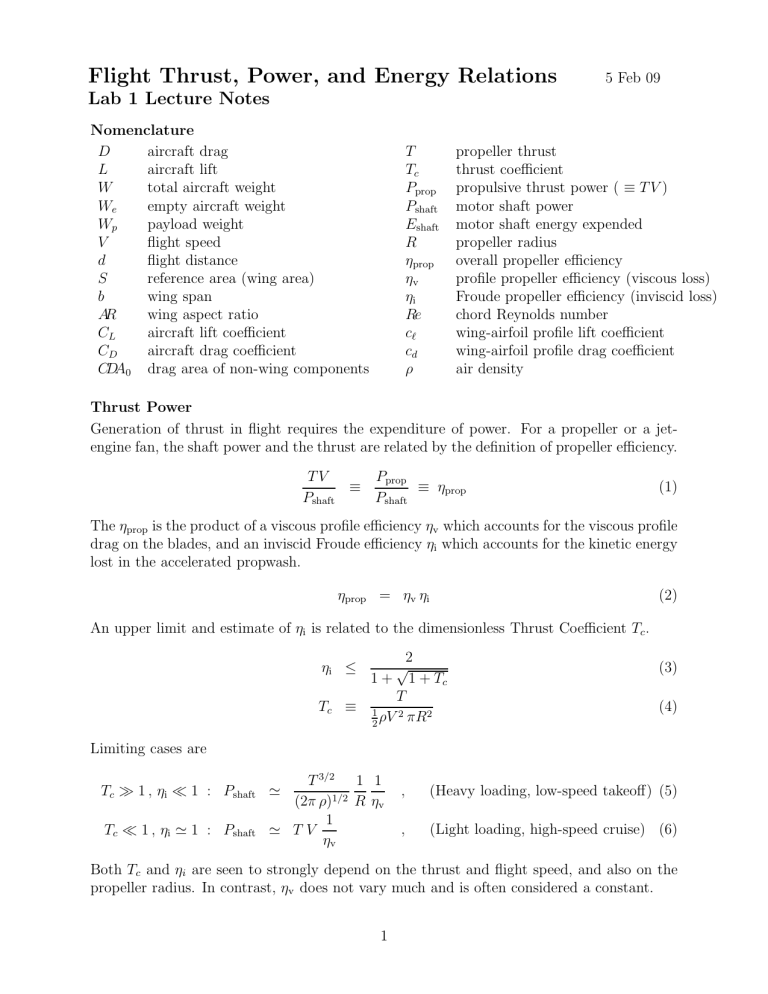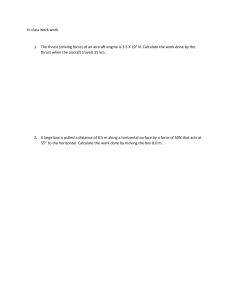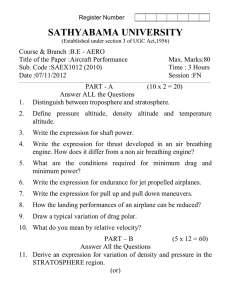
Flight Thrust, Power, and Energy Relations 5 Feb 09 Lab 1 Lecture Notes Nomenclature D aircraft drag L aircraft lift W total aircraft weight We empty aircraft weight Wp payload weight V flight speed d flight distance S reference area (wing area) b wing span AR wing aspect ratio CL aircraft lift coefficient CD aircraft drag coefficient CDA0 drag area of non-wing components T Tc Pprop Pshaft Eshaft R ηprop ηv ηi Re cℓ cd ρ propeller thrust thrust coefficient propulsive thrust power ( ≡ T V ) motor shaft power motor shaft energy expended propeller radius overall propeller efficiency profile propeller efficiency (viscous loss) Froude propeller efficiency (inviscid loss) chord Reynolds number wing-airfoil profile lift coefficient wing-airfoil profile drag coefficient air density Thrust Power Generation of thrust in flight requires the expenditure of power. For a propeller or a jetengine fan, the shaft power and the thrust are related by the definition of propeller efficiency. TV Pprop ≡ ≡ ηprop Pshaft Pshaft (1) The ηprop is the product of a viscous profile efficiency ηv which accounts for the viscous profile drag on the blades, and an inviscid Froude efficiency ηi which accounts for the kinetic energy lost in the accelerated propwash. ηprop = ηv ηi (2) An upper limit and estimate of ηi is related to the dimensionless Thrust Coefficient Tc . 2 √ 1 + 1 + Tc T ≡ 1 2 ρV πR2 2 ηi ≤ (3) Tc (4) Limiting cases are T 3/2 1 1 (2π ρ)1/2 R ηv 1 ≃ TV ηv Tc ≫ 1 , ηi ≪ 1 : Pshaft ≃ , (Heavy loading, low-speed takeoff) (5) Tc ≪ 1 , ηi ≃ 1 : Pshaft , (Light loading, high-speed cruise) (6) Both Tc and ηi are seen to strongly depend on the thrust and flight speed, and also on the propeller radius. In contrast, ηv does not vary much and is often considered a constant. 1 Level-Flight Relations In level flight we have W = L, which gives the velocity in terms of aircraft parameters. 1 2 ρV S CL 2 !1/2 2W = ρ S CL W = L = V (7) (8) In steady level flight we also have T = D, in which case the thrust and the propulsive thrust power can then be given as follows. T = D = Pprop = T V = DV 1 2 CD ρV S CD = W 2 CL 1 3 = ρV S CD = 2 2W 3 ρS (9) !1/2 CD 3/2 CL (10) In the level-flight case we can also express the thrust coefficient and hence the prop Froude efficiency in an alternative and somewhat more convenient manner. Tc = T 1 ρV 2 2 πR2 = D S = CD πR2 πR2 1 ρV 2 2 (11) Drag Breakdown To obtain the required thrust or propulsive power via (9) or (10), we need the overall aircraft drag coefficient CD , which is broken down into three basic components. CD = CDA0 CL2 + cd (CL , Re) + S π AR (12) The first term gives the combined drag of all the non-wing components, such as the fuselage, tail, landing gear, etc. The second term is the wing profile drag, estimated from the wing’s 2D airfoil cd (cℓ , Re) data, and by assuming that the typical wing airfoil operates at cℓ ≃ CL . The last term is the induced drag coefficient CDi , which depends on CL and the aspect ratio of the wing. AR = b2 S (13) Figure 1 shows the three CD components versus CL for a typical 1.5 m span light RC sport aircraft. For a typical operating point at CL = 1.0 (low speed) and CL = 0.3 (high speed), indicated by the symbols in Figure 1, the three components contribute roughly the following percentages to the total drag: CL CDA0 /S cd CL2 /πAR CD 1.0 0.3 1.0 0.3 0.0167 0.0167 18 % 39 % 0.0335 0.0220 37 % 52 % 0.0406 0.0037 45 % 9% 0.0909 0.0424 100 % 100 % 2 1.6 1.4 CDAo/S cd CDi CD 1.2 CL 1.0 0.8 0.6 0.4 0.2 0.0 0.00 0.02 0.04 0.06 0.08 CD 0.10 0.12 0.14 0.16 Figure 1: Drag polar and drag polar components for electric sport aircraft. AR = 9.0 10 Pprop [W] 8 6 4 2 0 0 2 4 6 8 10 12 14 V [m/s] Figure 2: Propulsive thrust power Pprop = DV = T V for electric sport aircraft. The corresponding propulsive power is shown in Figure 2. Minimum Flight Energy for Given Payload It is of great interest to reduce the flight energy (and hence the fuel consumption) of an aircraft as much as possible, while still carrying the required payload. Assuming that the total aircraft weight does not change appreciably during flight, the time t and shaft energy Eshaft required to fly a distance d is t = d V (14) Eshaft = Pshaft t = Td ηprop (15) Combining the relations and assumptions above, we have the following summary relations 3 for a sustained level flight of distance d. Eshaft Pshaft s CD 1 1 1 S + CD (We + Wp ) d = 1+ 2 ηv 2 2 πR CL s 2(We + Wp )3 1 1 1 S + C = 1+ D ηv 2 2 πR2 ρS where CD = !1/2 CD 3/2 CL C2 S CDA0 + cd (CL , Re) + L 2 S π b (16) (17) (18) The auxilliary CD expression (18) is the same as (12), restated here for convenience. Parameter Coupling and Design Optimization Any change in the aircraft variables which permits a reduction of Eshaft as given by equation (16), with a fixed Wp , will give a reduction in energy or fuel consumption. However, it’s essential to realize that most of the variables and parameters in equations (16) and (18) are coupled in an actual design application, so the effect of changing one will have multiple side effects, with the net effect being nonobvious. One example which might appear if one attempts to reduce Eshaft by increasing the wing area S. One immediately-apparent benefit of a larger S is: • Pro: Reduction of the first CDA0 term in (18) There are also obvious drawbacks: • Con: Increase in the first propeller loss term in (16) • Con: Increase in the last induced drag term in (18) Furthermore, there will likely be additional drawbacks which are not explicitly apparent: • Con: Increase in the empty weight We because of more wing material, etc. Other Pros and Cons may be present in addition to those listed above, depending on the situation. Much of the activity which occurs during aircraft design and sizing consists of identifying and quantifying such couplings. Knowing the couplings then allows suitable tradeoffs to be performed, in order to find the best set of design parameters to maximize the design objective. Once a good or optimum design has been reached, all its competing tradeoffs are in balance, so that there are no more “easy” design changes which can be made without adversely affecting something else. 4





